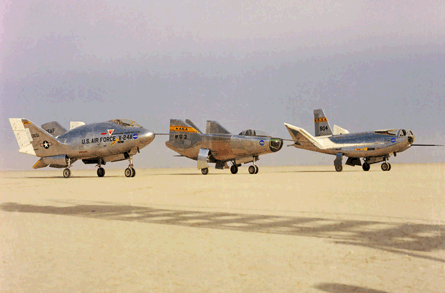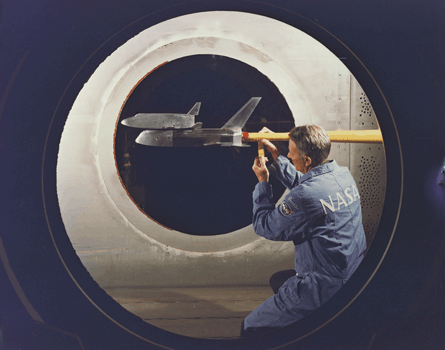For Project Mercury, it was Sputnik. For Project Apollo, it was President Kennedy's 1961 pledge to beat the Russians to the Moon. NASA's earliest ventures into manned spaceflight always seemed to begin with a stirring - and publicly useful - rallying cry.
It was not to be, however, with the Space Shuttle.
By the time NASA signed a $2.6 billion contract on 9 August 1972 for Rockwell to develop the Space Shuttle orbiter, the geo-political landscape had changed within four months of the final lunar mission.
A new policy of détente had already begun to warm relations within the Soviet-American rivalry, even as economic pressures were strangling NASA's post-Apollo budget.
 |
|---|
© NASANASA built a fleet of wingless lifting bodies to study aerodynamics for controlling and landing a re-entry vehicle |
Against this new backdrop, the Space Shuttle programme would have to survive without Kennedy's rallying call for Apollo. As historian Ray Williamson wrote in 1995, the Shuttle would instead emerge "over time in increments while NASA was simultaneously completing work on the Saturn V and launching the Apollo astronauts to the Moon and back".
The original justification of a reusable "Earth-to-orbit" Shuttle bears little resemblance to what the Nixon administration launched in the early 1970s. Even before the Apollo programme, NASA officials had envisaged a space station that would require a reusable spacecraft.
While Nixon's budget staff approved the Shuttle, the space station was deferred.
Texas A&M University professor emeritus of history Henry Dethloff summarised the Shuttle's existential plight at the moment of contract award. "When the Shuttle appeared without a space station to build and service, it appeared emasculated and detached from its intended purpose - to some extent an aerospace plane without a space mission," he wrote in a 1998 essay published by NASA.
A Shuttle-only space programme had never been contemplated until virtually contract award. In the late 1950s, NASA's founding vision had been to based on a logical, step-by-step approach to manned spaceflight. First, the agency would launch rockets bearing crew capsules. Then, a space station would be placed in orbit, to be serviced later by a Shuttle. Finally, lunar and perhaps even planetary missions would be dispatched from the orbiting station.
Kennedy's 1961 speech nixed the original plan, mandating a risky lunar mission. Ten years later, the political priorities of the Nixon administration again pushed the space station to the background.
An internal NASA analysis published on 12 May 1970 still assumed a future Shuttle programme would be launched primarily to support a space station.
"The first job is to provide round trip transportation for space station logistics and independent shuttle missions," says the Space Transportation System Analysis by E D Marion. NASA's early analyses contemplated annual launch rates of 100 sorties by the Shuttle fleet.
 |
|---|
© NASANASA fully reusable two stage shuttle concept |
In the absence of the space station, the mission of the Shuttle fleet naturally changed. In some ways, the Shuttle would become its own temporary, orbiting space station for the first two decades of its service life. The Shuttle also would deliver satellites into orbit. But it would be nearly 30 years before the programme would fulfil its original mission, with on-orbit construction of the International Space Station starting in 1998.
Despite the loss of its original mission, the programme's engineering staff got on with the task of solving the formidable challenges presented by Shuttle flight.
Despite the Apollo programme successes, NASA engineers in the early 1970s had little data to support trade studies associated with the design of a large, winged spacecraft.
Experiments such as the 16.8m (55ft)-long Bell X-15 had gathered data on low-hypersonic aerodynamics. Two other programmes - Aerothermodynamic-elastic Structural Systems Environment Tests and Precision Recovery Including Maneuvering Entry - provided orbital data on 1.8m and 2.4m vehicles. Meanwhile, the X-24 lifting body programme had explored aerodynamics at re-entry, but at subsonic and transonic speeds.
 |
|---|
© NASA |
But the data was not sufficient to guide aerodynamicists with the challenge of designing a 37.2m-long vehicle with a 23.8m wingspan. Early design concepts revealed that NASA's Shuttle configuration evolved dramatically. In the late 1960s, the focus was on fielding winged first-stage rocket that could fly back to the landing page. The reusable rocket concept was abandoned when budget estimates topped $12 billion for the overall programme.
Keeping the reusable orbiter on track for first flight would be difficult enough. The first flight of Space Shuttle Columbia in 1978 was delayed by three years. NASA's official history cites unexpected challenges with qualifying a space vehicle. But Williamson clarifies that qualifying the thermal protection system for such a large aircraft proved the hardest challenge.
Source: Flight International


























